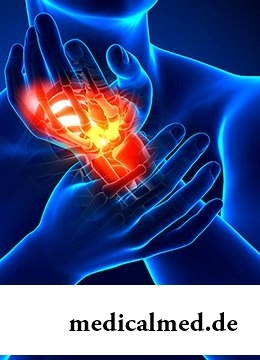





Syndrome of a carpal tunnel
 In medicine it is accepted to call group of defeats of peripheral nerves because of long squeezing or traumatic effects in musculoskeletal channels tunnel neuropathies or syndromes. The most widespread of tunnel neuropathies is the syndrome of a carpal tunnel which can be characterized as a prelum of a median nerve under a cross ligament of a wrist. It occurs between three bone walls and a sheaf holding sinews which bend a brush and fingers.
In medicine it is accepted to call group of defeats of peripheral nerves because of long squeezing or traumatic effects in musculoskeletal channels tunnel neuropathies or syndromes. The most widespread of tunnel neuropathies is the syndrome of a carpal tunnel which can be characterized as a prelum of a median nerve under a cross ligament of a wrist. It occurs between three bone walls and a sheaf holding sinews which bend a brush and fingers.
Reasons of a syndrome of a carpal tunnel
According to various statistical data, the syndrome of a carpal tunnel occurs among female population of the planet at 3-10 times more often than among men's. It is known that though the disease is observed at different age groups, the most part of cases are the share of aged people from 40 to 60 years. Also it should be noted that this pathology is inherent in preferential Caucasian race, and it almost does not occur among some African people.
Perhaps, it is caused by the fact that various situations which provoke inflammatory processes and puffiness in muscles, sinews and a joint of the tunnel are the main reason for a syndrome of a carpal tunnel. It is work behind the typewriter, long occupations on a piano and, of course, the computer. For this reason informally this pathology is also called a syndrome of a computer mouse. Actually any work demanding frequent repeated movements can act as a cause of illness.
Among other reasons of a syndrome of a carpal tunnel it is possible to note the following, the most widespread:
- Various rheumatic states which affect the area of a wrist and a hand leading to chronic inflammatory processes (for example, a pseudorheumatism);
- Pregnancy, especially on deadlines;
- Use of oral kontratseptichesky means (as well as in case of pregnancy, can promote a delay of liquid and, therefore, puffiness of hands);
- Tumor of a median nerve;
- Various injuries of a forearm and brush, such as changes, bruises and dislocations;
- The pathological increase in hands called by an acromegalia;
- Endocrine diseases (for example, diseases of a thyroid gland, diabetes mellitus, early period of a menopause etc.);
- Diseases of internals (for example, renal failure);
- Other occupations demanding capture and regular strong compression of a wrist.
Specialists quite often note interrelation between an aggravation of a syndrome of a carpal tunnel and cold season that demonstrates that overcooling of an organism also promotes development of a disease.
Symptoms of a syndrome of a carpal tunnel
Symptoms of a syndrome of a carpal tunnel quite specific so sometimes it is possible to determine by them without effort existence of this disease at the person. The most widespread of them is the following:
- Pricking, burning and pain in hands and forearms;
- Wastage of sensitivity and numbness around a wrist;
- Motive disturbances;
- Signs of disturbance of microcirculation of wrists.
Pain at an early stage of a syndrome of a carpal tunnel is, as a rule, observed in deep tissues of index and average fingers. Pain which is aching and the stupid, quite often passing into the area brushes and forearms. In most cases it is followed by numbness of skin of fingers and brushes, days, after awakening especially in the morning.
Often numbness leads to considerable decrease or even to full loss of painful sensitivity at first in palms, and then and in all hand. Several hours later such state usually passes. It is also possible to lower hands down and to move fingers: it helps to eliminate unpleasant feelings for a while.
Gradual motive disturbances act as the following symptom of a syndrome of a carpal tunnel. In process of development of a disease it becomes difficult for person to hold in hands even small objects, and force of their capture by a brush by means of a hand thumb considerably decreases.
Disturbance of microcirculation in hands is one more common symptom of a syndrome of a carpal tunnel. They are shown, first of all, by means of a vasospasm. It caused pallor of skin of hands at patients, its bluish shade and a cold snap which can be checked наощупь. Besides, disturbance of microcirculation leads to strengthening or decrease in sweating at people with a syndrome of a carpal tunnel, and also to disturbance of food of skin and nails that is shown by deterioration in their outward.
Diagnosis and treatment of a syndrome of a carpal tunnel
Except the above described symptoms of a disease, it can be defined by means of diagnosis by some tests. The test of bending and extension helps to reveal existence of a syndrome as follows. The healthy person has a hand in the provision of the maximum bending or extension there can be about a minute. However at patients with this pathology during this time prickings around fingers are observed.
Tinnel's test is based on percussion on area of the tunnel which causes pain and a pricking in fingers. However it is effective in cases of heavy degree of a syndrome.
Treatment of a syndrome of a carpal tunnel can be subdivided on conservative and surgical, depending on disease severity. Conservative treatment can be divided into three groups:
- Restriction of movements;
- Physical therapy;
- Treatment by medicines.
 Restriction of movements assumes a condition of rest of area of a sick brush throughout a long time. Sometimes imposing of tires on a wrist is required.
Restriction of movements assumes a condition of rest of area of a sick brush throughout a long time. Sometimes imposing of tires on a wrist is required.
The physical therapy is directed to creation of magnetic field. At such treatment of a syndrome of a carpal tunnel often use acupuncture which recovers exchange processes in the damaged fabrics.
Drug treatment most often includes use of non-steroidal anti-inflammatory drugs for elimination of pain, introduction of glucocorticoids and use of diuretics for removal of hypostases and an inflammation. Besides, at a syndrome of a carpal tunnel quite often register the drugs recovering microcirculation and functions of a median nerve.
Surgical intervention is applied in case conservative treatment is inefficient. It, as a rule, consists in a section of a cross ligament of wrist that allows to take off pressure upon sinews and a median nerve, and also to recover normal microcirculation of fabrics of a brush.
Statistically, on Mondays the risk of getting injured of a back increases by 25%, and risk of heart attack – for 33%. Be careful.

The state of health of the person in many respects depends on chemical composition of biological liquids of an organism. Specialists consider that з...
Section: Articles about health
Aspirin (acetylsalicylic acid) – one of those drugs which are known literally to all. It is available in each home first-aid kit, and many accept it at the first signs of an indisposition, often without having a fair idea of properties and a therapeutic eff...
Section: Articles about health
The technique of acupuncture (acupuncture) is used in the medical purposes more than three and a half millennia. It is eurysynusic and recognized as official medicine in the majority of the developed countries of the world. Influence by fine needles on so-called points of acupuncture contributes to normalization of a metabolism and hormonal background, activates protective forces of an organism, has anesthetic and antiinflammatory effect, stabilizes a condition of mentality....
Section: Articles about health
The medicine promptly develops, and the fact that else quite recently it seemed by miracle can now. We are not surprised any more to the fact that sport...
Section: Articles about health
Extracorporal fertilization – one of the most modern methods of controlling with infertility. So far he already helped a significant amount of married couples to become happy parents. Usually to the EKO procedure difficult and very expensive, resort in those...
Section: Articles about health
An eye of the person daily experiences considerable strain. The problem of preservation of sight is for many years directly connected with a question of supply of tissues of eye enough oxygen and nutrients. This task is carried out by small vessels – capillaries. For normal functioning of the visual device extremely important that they kept the integrity, but it works well not always. Microtraumas of eye vessels during which there are small hemorrhages it is extraordinary расп...
Section: Articles about health
The list of stereotypes of which, apparently, all know strongly includes following: British surely eat for breakfast овсянк...
Section: Articles about health
Proofs of efficiency of Mildronate at treatment of coronary heart disease with stenocardia can be found in many publications of the end of the twentieth century. Researches were conducted since 1984, including placebo - controlled effects. In total клиничес...
Section: Articles about health
All diseases from nerves – in this joke a big element of truth, are said by doctors. Constant stresses lead to decrease in protective forces of an organism, and it becomes vulnerable for a set of diseases. It is wrong to think that the stress is a problem of the present. Life of people and hundred, and one thousand years ago also abounded with problems therefore need of a relaxation understood in ancient times – to some techniques more than one thousand years. The person needs knowledge of how it is possible to relax, this knowledge пригод...
Section: Articles about health
For most of the working people the problem of having a snack is particularly acute enough. Sooner or later there is a question: what is possible quickly for a sja...
Section: Articles about health
The drugs stopping or oppressing life activity of pathogenic microorganisms are widely applied in clinical practice from 40th years of the last century. Originally antibiotics were called only substances natural (animal, vegetable or микробног...
Section: Articles about health
Aging — natural and inevitable process. Over time our skin loses elasticity, on it saggings are formed, the face form loses former clearness. The procedure of nitevy lifting (nitevy tightening) can successfully solve this problem. In order that it is better to get acquainted with this popular procedure, we will tell you 6 cognitive facts about it....
Section: Articles about health
Energy saving lamps are one of the most popular products of innovative technologies, and there is no wonder: they much эк...
Section: Articles about health
Musicotherapy – a treatment method which caused and causes a set of a controversy concerning its efficiency. However the facts are relentless: during the numerous researches curative impact of music on an organism was scientifically confirmed. Since then in a number of the countries a method...
Section: Articles about health
The brain of the person is studied not one hundred years, but the quantity of the riddles connected with this body increases rather, than decreases. Perhaps, numerous delusions concerning a structure and functioning of a brain are explained by it, many of which arose long ago, but continue to exist and today. Such we are ready to acquaint readers with the most widespread myths....
Section: Articles about health
The unpleasant feelings connected with spring breakdown are familiar almost to each of us. Often happens that in March-April on the person...
Section: Articles about health
Olive oil – the product capable to make a powerful contribution to health of the person if it includes it in the diet. The rich vitamin composition of oil does it by a product number one from many diseases including from deadly. Only two tablespoons...
Section: Articles about health
Good appetite was always considered as a sign of good health. The correct operation of the mechanism which is responsible for the need for nutrients and receiving pleasure from process of its satisfaction demonstrates that the organism functions without special deviations. On the other hand, appetite of the person is not a constant. It depends on the culture of food, flavoring addictions imparted since the childhood which can change during life, weather, mood and many д more than once...
Section: Articles about health
Feeding by a breast - the integral part of ideal motherhood allowing to come into contact with the kid and to create since early years...
Section: Articles about health
Vitamin complexes belong to the most popular drugs, probably, in our country there is no person who was not hearing about advantage of vitamins and never their accepting. The more vitamins, the better, we consider and as it appeared, cruelly we are mistaken. So l...
Section: Articles about health
Bees – really unique beings. Practically all products of their life activity are used by the person. Since the most ancient times medicinal properties of honey and other substances received in the course of beekeeping are known. The fact that all these products are recognized not only national, but also official medicine is especially significant. About influence and routes of administration of bee "drugs" the speech in this article will also go....
Section: Articles about health
Bathing in broths of medical flowers and plants (phytobathtub) was eurysynusic since Cleopatra who is a good judge of everything...
Section: Articles about health
When overcomes feeling of hunger, and an opportunity to have dinner fully is absent, having a snack − the meals, small on volume, stabilizing sugar level in blood comes to the rescue. The relation of nutritionists to having a snack is more often negative, but only because in кач...
Section: Articles about health
The kid who was recently born is surrounded with love of adult family members and their cares without which the baby cannot exist. Some parents consider that gentle attachment and caress are quite enough that the child correctly developed and was happy, but it not so. It is important to know as much as possible about specifics of care of the baby, the reasons of his behavior and possible problems. Only the "able to see" love will provide to the little man that it is necessary for him....
Section: Articles about health
Producers of milk mixes for children assure: mixes are ideally balanced and adapted for needs of babies. In a sluch...
Section: Articles about health
Season of activity of viral infections in the heat. Everyone can get sick, but probability of this unpleasant event it is possible and it is necessary to minimize. There is a number of rules, following to which will help or to avoid absolutely infection with flu or a SARS, or to have an illness...
Section: Articles about health
Statistically, can only one of ten of our compatriots brag of a decent condition of an oral cavity. Six teeth affected with caries are the share of the average Russian. For comparison, this indicator for Europeans is almost six times less....
Section: Articles about health
